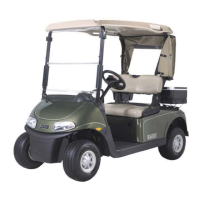66
FUEL SYSTEM
Read all of SAFETY and this section before attempting any procedure. Pay particular attention to Notices, Cautions, Warnings and Dangers.
FUEL PUMP
The fuel pump is mounted on a bracket attached to the
seat support near the fuel tank. It is operated by crank-
case pressure impulses from the engine. As the piston
moves up in the cylinder, a negative pressure moves the
diaphragm within the fuel pump (10). This movement
draws fuel from the fuel tank (26) into the fuel pump (10)
chamber. This action also closes the outlet valve which
prevents fuel back flowing from the carburetor.
As the piston moves down in the cylinder, a positive pres-
sure is formed in the crankcase which causes the dia-
phragm to move in the opposite direction (away from the
engine). This action forces the inlet valve to close and the
outlet valve to open and supply fuel to the carburetor float
bowl.
Fuel Pump Replacement
Tool List Qty.
Socket, 3/8” .................................................................1
Ratchet ........................................................................ 1
Pliers............................................................................ 1
Straight Blade Screwdriver .......................................... 1
Attempting to operate engine with lines reversed
will cause fuel enter the crankcase and dilute the oil
with possible engine damage.
The length of the pulse hose from the fuel pump is
important for efficient pump operation. To replace the
hose, make sure to replace with a hose of the same
length and approved material.
Observe and identify the supply and pulse hoses.
Remove the hoses and plug the fuel lines (44). Remove
the fuel pump (10) by removing the two screws that
secure it to the bracket located on the seat support frame
(Figure 11).
Installation is in the reverse order of removal. Be sure to
connect the pulse line to the correct location on the pump.
Fuel Lines and Filter
Tool List Qty.
Pliers............................................................................1
Straight Blade Screwdriver ..........................................1
The fuel is supplied to the fuel pump (10, 26) and carbu-
retor through flexible fuel hoses. An in-line filter (7, 13) is
installed in the hose between the fuel tank (26, 3) and the
fuel pump (10, 26) (Figure 11) (Figure 12).
If a test to determine fuel/vapor presence or
flow is required, the ignition system must be
disabled. Remove the spark plug wire in order
to decrease the risk of an ignition spark that
could ignite the fuel/vapor. Never permit smok-
ing or an open flame in an area that contains
fuel/vapor. Clean up all fuel spills immediately.
Early Production Vehicles
Frequently check the fuel filter (7), tank (26), hoses (19, 6,
17) and cap (3) for leaks or signs that the cap vent or filter
have become clogged (Figure 11). The filter must be
replaced periodically.
Late Production Vehicles
Frequently check the fuel filter (13), tank (3), hoses (7, 5,
9) and cap (4) for leaks or signs that the cap vent or filter
have become clogged (Figure 12). The filter must be
replaced periodically.
Refer to PERIODIC SERVICE SCHEDULE section.
The filter (7, 13) is marked with a flow direction
arrow. Be sure that the arrow points towards the
fuel pump.
To decrease the risk of injury from explosion or
fire, never attempt to repair a damaged or
leaking fuel tank. It must be replaced.

